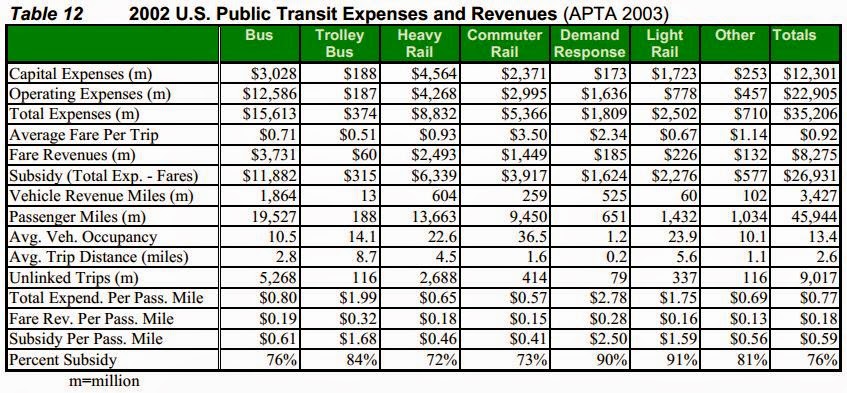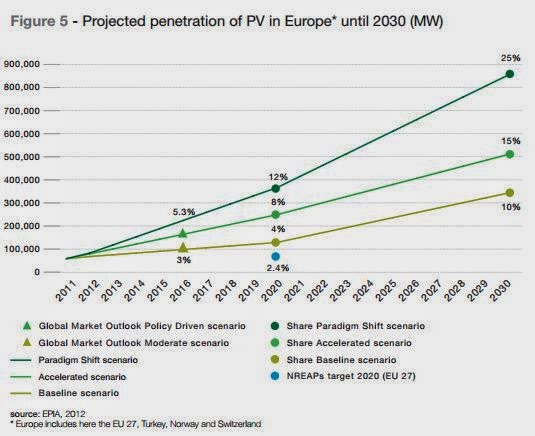Summary:
- Ridership increases due to BRT can be from -3% to +80% - around 30% is typical.
- Time decrease in journeys is between 26% to 35%
- BRT includes many components, of which a dedicated lane is neither necessary nor sufficient.
- BRTs with dedicated lanes can fail while those without dedicated lanes can be successful.
- BART is very unlikely to be extended parallel to El Camino.
(see also post on pblic transit subsidies here:
Ridership:
Most studies of BRT are done by advocates of BRT so it is welcome when one sees a study by the impartial General Accounting Office of the US Congress.
Source:
http://www.gao.gov/assets/600/592973.pdf
The argument for BRT is usually that by decreasing bus transit times, it will increase ridership and reduce traffic congestion. The GAO's study shows mixed results.
Even in the same city (LA) results vary from slightly negative ( a decrease) to a very high 70%. Many of the increases are less than 10%. Important to note that LA does
not use dedicated bus lanes. So a BRT does not, by itself, guarantee an increase in ridership and even when it does, it may be despite
not having a dedicated lane. (click graphic to enlarge).
In the Federal Transport Agency's report "BUS RAPID TRANSIT - Synthesis of Case Studies" (pro-BRT) we find the following for ridership increases in N. American cities:
(
http://bussafety.fta.dot.gov/uploads/resource/2986_filename )
"Los Angeles: 26 to 33% gain of which 1/3 were new riders.
Vancouver: 8,000 new riders of which 20% previously used cars and 5% represented new trips."
I have not included cities outside of the US or Canada because car ownership and city layout is much different. Non-US cities still have a central hub for work and shopping, and often a lower car ownership rate while US cities are more dispersed, without a central work-shopping hub,
Another study of BRT (an advocacy paper) showed a ridership increase in LA corridors of 27% (Wilshire) and 42% (Ventura). Weekday corridor revenue service increase was a weighted average of 32%. Source
Travel speed is not very high:
"Arterial Streets:
Express, Bogotá, Curitiba: 19 mph
Metro bus, LA Ventura Blvd., 19mph
Metro bus, LA Wilshire Blvd. and Wilshire Blvd, L.A.: 14 mph
All-Stop – Median Busways, South America: 11-14 mph
Limited Stop Bus Service – New York City: 8-14 mph"
Source:
http://bussafety.fta.dot.gov/uploads/resource/2986_filename
Whether these results can be applied to mixed suburban-office areas like Silicon Valley is an open question as the writers note that:
"Urban areas with more than a million residents and a central area employment of at least 80,000 are good candidates for BRT. These areas generally have sufficient corridor ridership demands to allow frequent all-day service."
The above description does
not seem to fit the Palo Alto-Santa Clara corridor. The total 2013 census estimate of population of the proposed El Camino BRT (pop. Palo Alto = 66K, Mountain View = 78K, Sunnyvale = 148K, and Santa Clara = 120K) is 412K. This is well less than 50% of the recommended population. (pop figures from
http://quickfacts.census.gov/qfd/states/06/0677000.html)
Further, employment is
NOT centrally located but is scattered hither and yon.
 |
| BRT in Guang-Zhou, China, pop. 11M |
In the above photo of the BRT in Guang-Zhou a dedicated lane BRT makes a lot of sense where the population is very high (11M + many millions uncounted transient workers) and very dense and most people still don't own cars. It also has 6 lanes for cars in addition to the two restricted lanes for buses and center walkways.
http://www.metro-magazine.com/news/story/2011/01/chinese-brt-system-wins-sustainable-transport-award.aspx
https://en.wikipedia.org/wiki/Guangzhou#Public_transport
The time savings varies a lot as well from about 5% to almost 35% from the GAO study mentioned above. (click graphic to enlarge).
In the report "BUS RAPID TRANSIT - Synthesis of Case Studies" mentioned above we find the following for transit time savings in N. American cities:
"Reported travel time savings are as follows:
Busways, Freeway Lanes: 32-47%
Seattle’s Bus Tunnel: 33%
Los Angeles Metro Bus: 23-28%"
What Is Bus Rapid Transit?
On page 13 of the Federal Transportation Administration document (here:
http://bussafety.fta.dot.gov/uploads/resource/2986_filename ) seven characteristics that constitute a BRT are listed, of which only one is dedicated lanes and this is listed as optional. On page 28 of that same document, (first sentence in section 3.A.3) it states that "BRT service operates successfully in mixed traffic as seen in Los Angeles."
The very much pro-BRT Institute for Transportation and Development Policy (ITDP) (
https://www.itdp.org/) has issued a set of standards that need to be met to qualify as a BRT.
https://www.itdp.org/?s=brt+standard
The concern is that some cities are claiming they have a BRT when they don't and it is tarnishing the image of BRTs everywhere. The ITDP has devised a scorecard for BRTs. Of the many, many criteria (each assigned a point value of 1 to 8) a dedicated bus lane is only one and that gets only 8 points, out of a maximum of 100 points. A partial list of the approximately 25 criteria to be met (as seen in the "standards" link above) is shown below (click to enlarge):
Two of the lowest ranking BRTs have dedicated bus lanes, but they do so many other things wrong that they get a failing grade - like 22 points for Delhi's system, and Virginia's
Shirley Highway Busway, which is about to be killed. A list of mistakes with point deductions is below.
Cf: the marvelously titled
"Do Bus Rapid Transit Right, And It Won’t Get Killed" by ITDP's staff.
http://nextcity.org/daily/entry/do-bus-rapid-transit-right-and-it-wont-get-killed
A go-slow approach to bringing up BRT would make a lot of sense. No permanent major changes to arterial flow but rather an incremental approach adding those many things listed in the ITDP scorecard which improve speed without impacting traffic flow.
For example,
- Having the ability to pre-pay by buying a ticket at a bus stop would shorten bus stops.
- Elevated entries so wheel-chair and walker users could enter more quickly and easily.
- Distance between stops could be increased so buses stop less often and average higher speeds.
- During rush hour, one could have one bus stop at stations 1-3-5 and the next bus 5 minutes later at stations 2-4-6 so everyone could get close to their destination while buses needn't stop so often.
- Bus lanes could be marked with removable plastic dividers or special markings on the lane like commuter lanes on the freeway. They could be used during rush hours to see if it makes a difference in overall transit speed. There is no necessity to pour lots of concrete to make bus lanes when they really might only help during rush hours. An example (below) is from Newark's BRT. Source https://en.wikipedia.org/wiki/Bus_rapid_transit_in_New_Jersey
 |
| New Jersey BRT without concrete barriers |
 |
| One of San Francisco's BRT proposals along Van Ness |
San Francisco did an extensive study of BRT options along Van Ness Ave. of which one is seen above. Ref:
http://www.sfcta.org/van-ness-avenue-bus-rapid-transit-feasibility-study
 |
| BRT with raised platform speeds up boarding of movement impaired |
None of this requires massive expenditures or drastically re-organizing cities or requires pouring lots of cement. Some cynics might argue that this removes the motivation for many of BRT's advocates who want a big ticket project to gloss their resumes or reward contractor campaign supporters. But I am not so cynical and believe that honest differences of opinion can be approached with an eye to compromise and a gradual approach to alleviate legitimate concerns.
Extending BART:
It is doubtful more subways will be built in the US given the high cost. (ref:
http://www.governing.com/columns/urban-notebook/When-Will-the-US-Build-Another-Subway.html).
The Bay Area Rapid Transit (BART) system is one of the most successful in the US. It is currently being extended further to the Berryessa area and Warm Springs (Fremont) and eventually to Santa Clara. The Berryessa extension is 10 miles and will cost an estimated $930M or $93M/mile. (ref:
http://www.vta.org/bart/faq#g) The Warm Springs extension will be 5.4 miles and will cost $890M or about $164M/mile. (
http://www.bart.gov/about/projects/wsx )
To extend BART further is not in the expansion plan at all for the simple reason it would duplicate existing heavy rail (CalTrain) which is closer to most employment centers and in some cases has stations right on El Camino or just a few blocks away from it. See BART map below (click to enlarge).
The Association of Bay Area Governments (ABAG) estimates the entire SF metropolitan area will grow by 2.1 million by
2040 from 7.2M to about 9.3M, a 29% increase over 26 years - 0.9% annual growth rate.
http://onebayarea.org/file10044.html
The state of CA estimates the SF area will grow by 1.8M by
2060 from 7.2M to about 9M, a 25% increase over 46 years, a 0.5% annual increase.
http://www.contracostatimes.com/ci_23151275/santa-clara-county-is-fastest-growing-county-population
With this growth comes higher rents and more traffic congestion. But there seems to be little money for expansion. One report estimates "Most of the transportation money in Plan Bay Area is earmarked for maintenance alone and there is still a $20 billion shortfall needed to keep the region’s transit systems in good repair for the next 30 years."
http://www.nbcbayarea.com/news/local/Bay-Areas-Population-Boom-a-Burden-on-Transportation-and-Housing-260805031.html
San Jose's light rail system is clearly a failure to those who study such issues although light rail works well in other areas. Even if it were later to get enough ridership to justify it's cost, building light rail is much more expensive than buses. Saying that because city X has a successful light rail clearly does not guarantee it will work in Silicon Valley.
Ref:
http://publictransport.about.com/od/Transit_War/a/Overview-Of-The-Bus-Rapid-Transit-Versus-Light-Rail-Debate.htm
Conclusion:
A BRT might ease traffic congestion. Whether it requires a dedicated lane to do so without a trial is impossible to say. Many characteristics of BRT can be implemented without dedicated lanes. Making it easier and faster to buy tickets and board would be good things to do in any event and should help decrease travel times and increase ridership. A dedicated lane
without these improvements will likely fail.
After all the other BRT related improvements have been implemented a dedicated lane
for rush hour only using painted road indicators allowing right turning vehicles with posted signs like other BRTs cited above might be the best of both worlds. If a rush-hour dedicated lane designated with paint fails to show further improvement in ridership - and it might - it can easily be undone.




































































